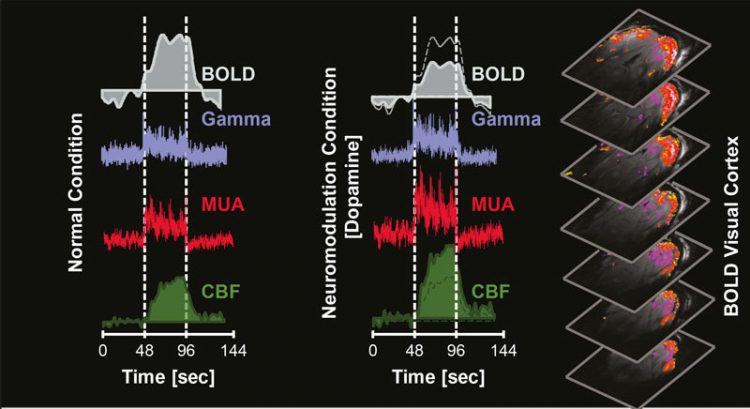Dopamine leaves its mark in brain scans

Dopamine alters the so-called BOLD signal in MRI: <b>Left:</b> If the visual cortex of the brain is active, the BOLD signal increases without dopamine. The activities of gamma waves, individual groups of nerve cells (MUA) as well as the blood flow in the area (CBF) also increase. <b>Centre:</b> Under the influence of dopamine, the BOLD signal decreases. The gamma-waves and the activity of the nerve cells, however, remain constant. The blood flow even increases. <b>Right:</b> Active regions (red) in the visual cortex of the brain. © MPI f. Biological Cybernetics / D. Zaldivar
Researchers use functional magnetic resonance imaging (fMRI) to identify which areas of the brain are active during specific tasks.
The method reveals areas of the brain, in which energy use and hence oxygen content of the blood changes, thus indirectly showing which cell-populations are particularly active at a given moment.
Researchers from the Max Planck Institute for Biological Cybernetics in Tübingen now demonstrate that activity induced by signalling molecules such as dopamine may yield hitherto unpredictable up or down modulations of the fMRI signals, with the result that the neural and vascular responses dissociate. In such cases, far more precise data can be obtained when fMRI is combined with concurrent measurements of cerebral blood flow.
When you work hard, you breathe heavily. The same applies to nerve cells. When neurons fire, they consume more oxygen that is being delivered through blood. To ensure that no deficiency occurs, an oversupply of oxygenated blood is immediately transported to active regions of the brain. As a result, the oxygen content of the blood rises in those areas. In a magnetic resonance -scanner, this process is measured in the form of a blood oxygenation level dependent (BOLD) signal. When the activity of nerve cells increases, the BOLD signal increases too – in theory.
However, external influences such as mood, age, drugs, and food can alter BOLD signals and thereby change the interpretation of fMRI results. Moreover, the results are also affected by different brain states such as attention, memory and reward. “There is no absolute correlation between neuronal activity and BOLD signals.
Consequently, our ability to interpret the signals from fMRI scans is limited,” says Daniel Zaldivar of the Max Planck Institute for Biological Cybernetics, describing the motivation starting point of his research. Together with his colleagues, he studied how nerve cells in the visual cortex of macaque monkeys respond to visual stimuli when the brain is simultaneously under the influence of dopamine. The surprising result: although the activity of the nerve cells increases, the BOLD signal decreases by about 50 percent. This can lead the viewer of a brain scan to erroneously conclude that these neurons are less active.
“Dopamine presumably causes active cells to consume more oxygen than can be delivered,” says Zaldivar. Paradoxically, dopamine ramps up neurons’ activity to such a degree that the BOLD signal shows exactly the opposite of what is really happening. Under the influence of dopamine and probably other neuromodulators, changes in the BOLD signal alone are therefore not sufficient to draw conclusions about the activity of neuronal cells.
Measurements of cerebral blood flow in combination with BOLD and neurophysiology offer better insight into the changes of energy metabolism and help to draw better conclusion about the neuronal cells activity. That is because cerebral blood flow provides more direct information about the delivery of oxygen. Interestingly, Zaldivar and colleges found that under the influence of dopamine, blood flow increased. This results lead to the conclusion that the increase along with the neural activity is driven by increased energy use.
“If we can improve our understanding of how BOLD signals change under the influence of neuromodulators, we may be able to interpret brain scans better and detect problems at an earlier stage,” says Zaldivar. In schizophrenia patients, for example, the dopamine system in the brain is poorly regulated. If scientists knew what impact neuromodulators such as dopamine have on brain scan images, it might be possible to diagnose such illnesses earlier. “Before drawing conclusions about neuronal activity from BOLD signals, we first need to know what influence neuromodulators have on the images,” says Zaldivar.
Contact
Prof. Dr. Nikos Logothetis
Max Planck Institute for Biological Cybernetics, Tübingen
Phone: +49 7071 601-651
Email: nikos.logothetis@tuebingen.mpg.de
Dr. Daniel Zaldivar
Max Planck Institute for Biological Cybernetics, Tübingen
Phone: +49 7071 601-657
Email: Daniel.Zaldivar@tuebingen.mpg.de
Dr. Jozien Goense
Institute of Neuroscience & Psychology
University of Glasgow
Email: Jozien.Goense@glasgow.ac.uk
Original publication
Daniel Zaldivar, Alexander Rauch, Kevin Whittingstall, Nikos K. Logothetis, Jozien Goense
Dopamine-induced dissociation of BOLD and neural activity in macaque visual cortex
Current Biology, 20 November 2014
Media Contact
All latest news from the category: Life Sciences and Chemistry
Articles and reports from the Life Sciences and chemistry area deal with applied and basic research into modern biology, chemistry and human medicine.
Valuable information can be found on a range of life sciences fields including bacteriology, biochemistry, bionics, bioinformatics, biophysics, biotechnology, genetics, geobotany, human biology, marine biology, microbiology, molecular biology, cellular biology, zoology, bioinorganic chemistry, microchemistry and environmental chemistry.
Newest articles

Properties of new materials for microchips
… can now be measured well. Reseachers of Delft University of Technology demonstrated measuring performance properties of ultrathin silicon membranes. Making ever smaller and more powerful chips requires new ultrathin…

Floating solar’s potential
… to support sustainable development by addressing climate, water, and energy goals holistically. A new study published this week in Nature Energy raises the potential for floating solar photovoltaics (FPV)…

Skyrmions move at record speeds
… a step towards the computing of the future. An international research team led by scientists from the CNRS1 has discovered that the magnetic nanobubbles2 known as skyrmions can be…





















